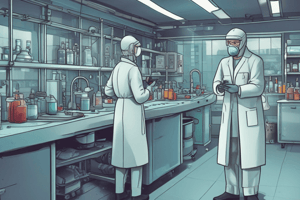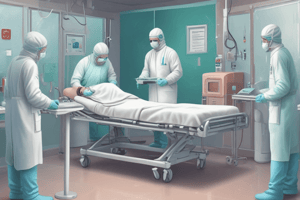Podcast
Questions and Answers
What does the abbreviation 'FDA' stand for?
What does the abbreviation 'FDA' stand for?
- Food and Drug Administration (correct)
- Food Defense Agency
- Financial Drug Administration
- Federal Department of Agriculture
Which abbreviation refers to the composition of blood?
Which abbreviation refers to the composition of blood?
- PCV
- L Por L
- COB (correct)
- FOB
Which type of transmission occurs when pathogens are spread through droplets expelled during coughing or sneezing?
Which type of transmission occurs when pathogens are spread through droplets expelled during coughing or sneezing?
- Droplet Transmission (correct)
- Airborne Transmission
- Vector-borne Transmission
- Direct Contact
What does the acronym PPE stand for in safety regulations?
What does the acronym PPE stand for in safety regulations?
Which abbreviation is associated with safety and procedures in a laboratory setting?
Which abbreviation is associated with safety and procedures in a laboratory setting?
What does the abbreviation 'PCD' refer to?
What does the abbreviation 'PCD' refer to?
Which type of precaution is primarily designed to prevent infections from bloodborne pathogens?
Which type of precaution is primarily designed to prevent infections from bloodborne pathogens?
What is the purpose of an Exposure Control Plan (ECP)?
What is the purpose of an Exposure Control Plan (ECP)?
What does 'SOP' signify in laboratory contexts?
What does 'SOP' signify in laboratory contexts?
What is the role of the Joint Commission in healthcare safety?
What is the role of the Joint Commission in healthcare safety?
Flashcards are hidden until you start studying
Study Notes
Precautions in Healthcare
- Regulatory agencies such as CDC and OSHA play vital roles in public health management.
- Direct Contact (DC) involves immediate physical interactions that may pose infection risks.
- Indirect Contact (IC) encompasses transmission through contaminated objects or surfaces.
- Droplet Transmission (DT) occurs when infectious respiratory droplets are expelled by coughing or sneezing.
- Airborne Transmission (AT) involves pathogens suspended in the air over long distances and durations.
- Vector-borne Transmission (VBT) refers to diseases transmitted via vectors, such as insects.
- OSHA mandates the use of Personal Protective Equipment (PPE) to protect against Bloodborne pathogens (HBV).
- Standard Precautions (SP) are infection control measures applied to all patients, regardless of diagnosis.
- Isolation Precautions (IP) are implemented to control the spread of infections to other patients and healthcare workers.
- Airborne precautions require the use of HEPA filtration, masks, or N95 respirators to minimize infectious agent spread.
- Droplet precautions involve wearing gloves and masks to protect against droplet transmission.
- Contact precautions necessitate the use of gowns to prevent transmission through physical touch with contaminated surfaces or materials.
- Protective Environment (PE) precautions specify conditions and PPE necessary to safeguard immunocompromised patients.
- Bloodborne Pathogens (BP) consideration is critical in preventing infections from blood exposure.
- Other Potentially Infectious Materials (OPIM) includes fluids like saliva, urine, and other bodily fluids that may contain pathogens.
- Exposure Control Plan (ECP) outlines procedures to minimize risks of exposure to infectious agents.
- Needlestick injuries require adherence to protocols set by NIOSH and OSHA for safety.
- Safety Data Sheets (MSDS or SDS) provide important information on handling and emergency measures for hazardous chemicals.
- Chemical Hygiene Plans (CHP) detail the protocols for safely handling chemicals in laboratory settings.
- Clinical Laboratory Improvement Amendments (CLIA) regulate laboratory testing to ensure accuracy and reliability.
- The Joint Commission (TJC) is responsible for overseeing healthcare quality and safety standards.
- Physician Office Laboratories (POL) require adherence to regulatory standards to maintain quality patient care.
Abbreviations Context
- EPA or TEPA stands for the Environmental Protection Agency, overseeing regulations to protect human health and the environment.
- JDOTOFDP refers to the Department of Transportation, which manages the transport of hazardous materials.
- FDA governs food safety, pharmaceuticals, and medical devices to protect public health.
- TC8 refers to the Cardiovascular System in medical contexts.
- ASV signifies Aorta Semilunar Valve, part of heart anatomy critical to blood circulation.
- PSV denotes Pulmonary Semilunar Valve, which facilitates blood flow from the heart to the lungs.
- PCD or PC stands for Pulmonary Circulation Deoxygenated, a cycle transporting deoxygenated blood to the lungs.
- SCG or SC refers to Systemic Circulation Oxygenated, encompassing oxygen-rich blood travel to body tissues.
- TOBV identifies Types of Blood Vessels, varying in structure and function throughout the circulatory system.
- COB includes the Composition of Blood, consisting of plasma, red blood cells, white blood cells, and platelets.
- PBC, or formed elements, represents components of blood crucial for immune response and clotting.
- L Por L refers to Leukocytes, cells that are essential to the immune system in fighting infections.
- BT encompasses ABO and H Blood Types, critical for blood transfusions and compatibility.
- M denotes Hemostasis, the process that prevents and stops bleeding.
- GA represents Quality Assurance, ensuring standards are met in healthcare settings.
- PO highlights Patient Outcomes, reflecting the effectiveness of healthcare interventions.
- QC denotes Quality Control, ensuring accuracy and precision in laboratory testing.
- SOP signifies Standard Operating Procedure, detailing methods to guarantee consistent practices.
- CM refers to Control Materials, used to verify the accuracy of laboratory tests.
- GT stands for Glucose Testing, an important procedure in monitoring diabetes.
- ESR represents Erythrocyte Sedimentation Rate, a test used for detecting inflammation.
- FOB indicates Fecal Occult Blood testing for gastrointestinal bleeding.
- PCV stands for Packed Cell Volume, a measure of red blood cell concentration in blood.
- UCT denotes Urine Chemical Testing, analyzing components in urine for diagnostic purposes.
- 001 refers to Commission Office Laboratory Accreditation, which ensures laboratories meet certain standards for safety and quality.
Studying That Suits You
Use AI to generate personalized quizzes and flashcards to suit your learning preferences.




